How to make Driving/Peak Time Techno with Captain Plugins

Motor City Beats
Techno is undoubtedly the king of underground dance music. It’s roots lie in the electro sound which was crafted in the early 1980’s by groups such as Karftwerk. However, Techno stamped its own identity in Detroit and Europe around the late 1980’s.
This new form of electronic music made heavy use of new synthesizer instruments, such as the Roland TR-909 and TB-3. It was pioneered by artists such as Kevin Saunderson and Juan Atkins. As with much electronic music, Techno quickly evolved. It scattered into sub-styles such as Dub, Acid, Ambient, Hardcore and more.
Driving/Peak Time
In this tutorial, I won’t be tackling the original Techno sound. Instead, I’m looking at a more contemporary style. It can be identified as Driving, or Peak Time and has been made popular by record labels such as Drumcode and Tronic and artists/DJs such as Adam Beyer, Nicole Moudaber and Christian Smith, to name but a few.
This style of Techno is quite melodic, by comparison to other sub-genres. This means it plays into Captain Plugins strengths. It’s usually produced in the 127-132bpm range and like most dance music it will usually be in a minor key. For this example track, which you can listen to a sample of below, I chose 130bpm and F minor.
How the arrangement looks in Logic and below is a clip of the example track.
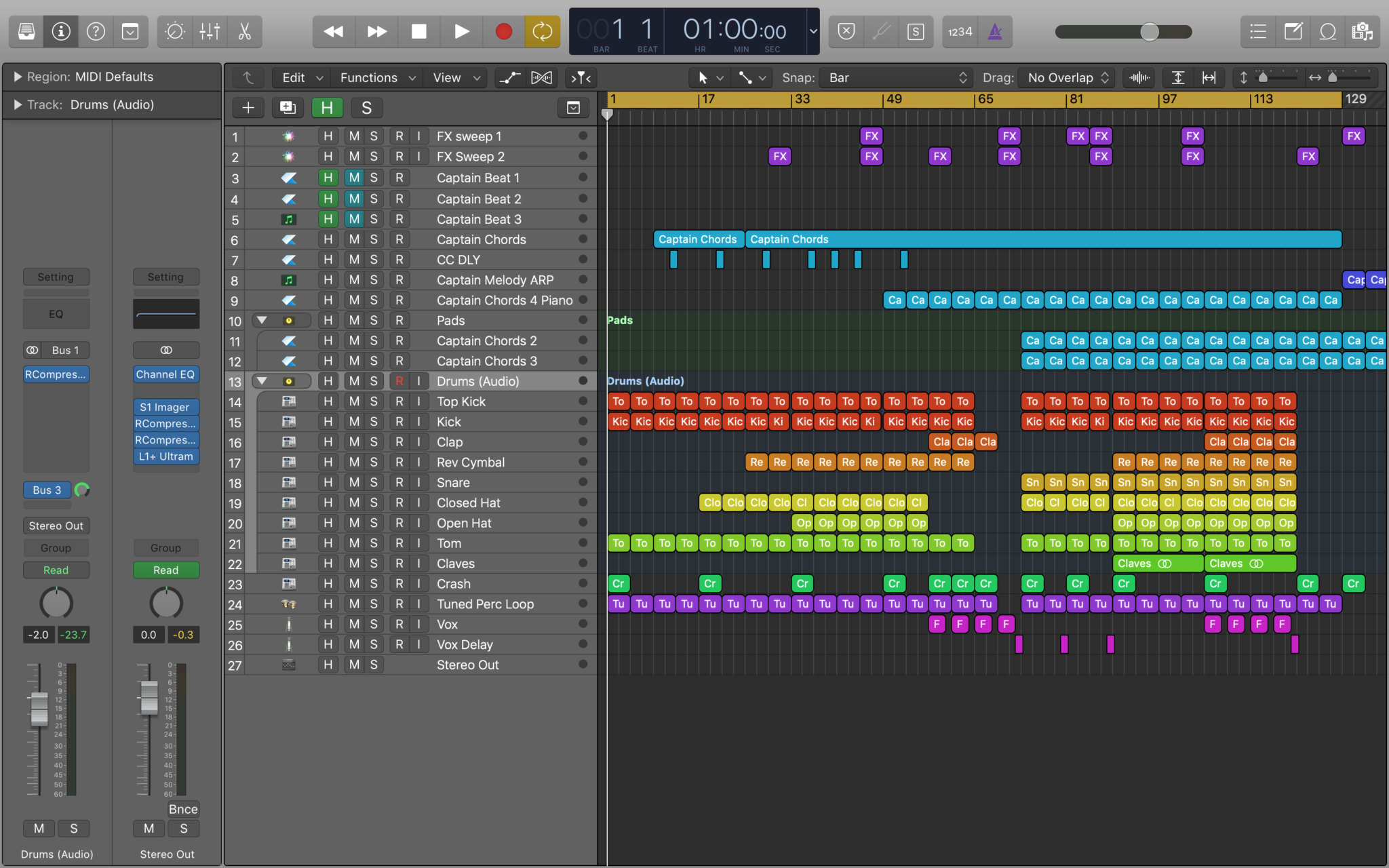
Write Chords Faster with Captain Chords
- Use Captain Plugins to write your own Chord Progressions, Hooks, Melodies and Basslines
- Export to your DAW
- Available on Mac and Windows.
The Tools Used
The meat of the track was made using Captain Plugins, with the help of Mixed In Key Studio Edition. There was also a lot of mixing and and use of effects such as filtering, side-chain compression, parallel processing and other mixing tricks. I won’t delve too much into those. However, if you aren’t familiar with them, I highly recommend looking them up here in our Captain Plugins Wiki as they’re very powerful techniques to add to your production arsenal.
Laying Down The Beat
As Techno is usually drum-centric, I feel that’s a great place to start. Thinking about the drum instruments and how they will affect the overall vibe is really important. For driving/peak time Techno, the kick should probably be snappy, not too punchy and able to cut through the mix – not unlike Trance or Psy-Trance in that regard. Claps from the TR-909 are always a winner in any form of Techno. I decided to use a mix of one-shot drum sounds from a Techno sample pack and some Roland TR-808/909 sounds which are built into Captain Beat.
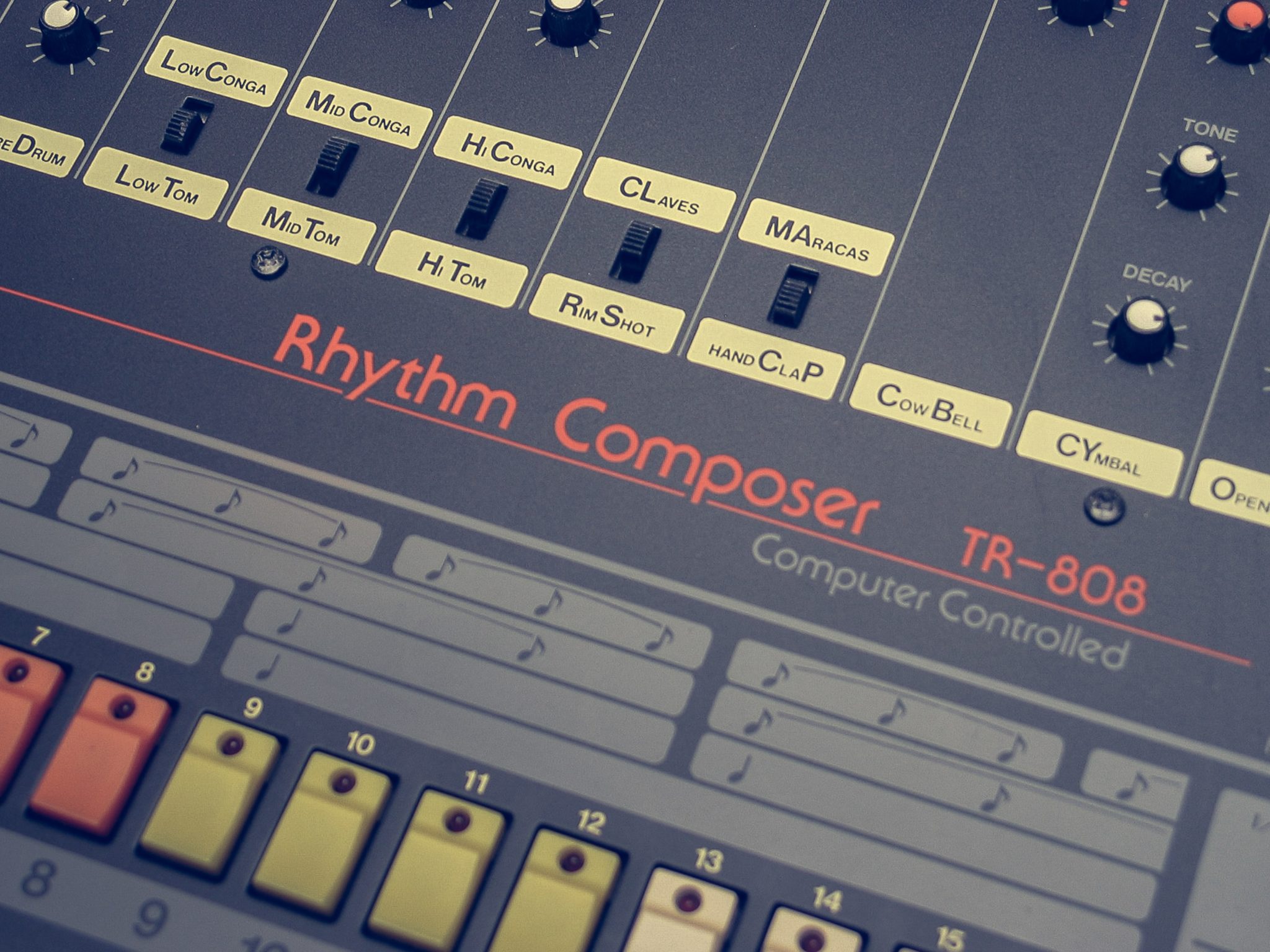
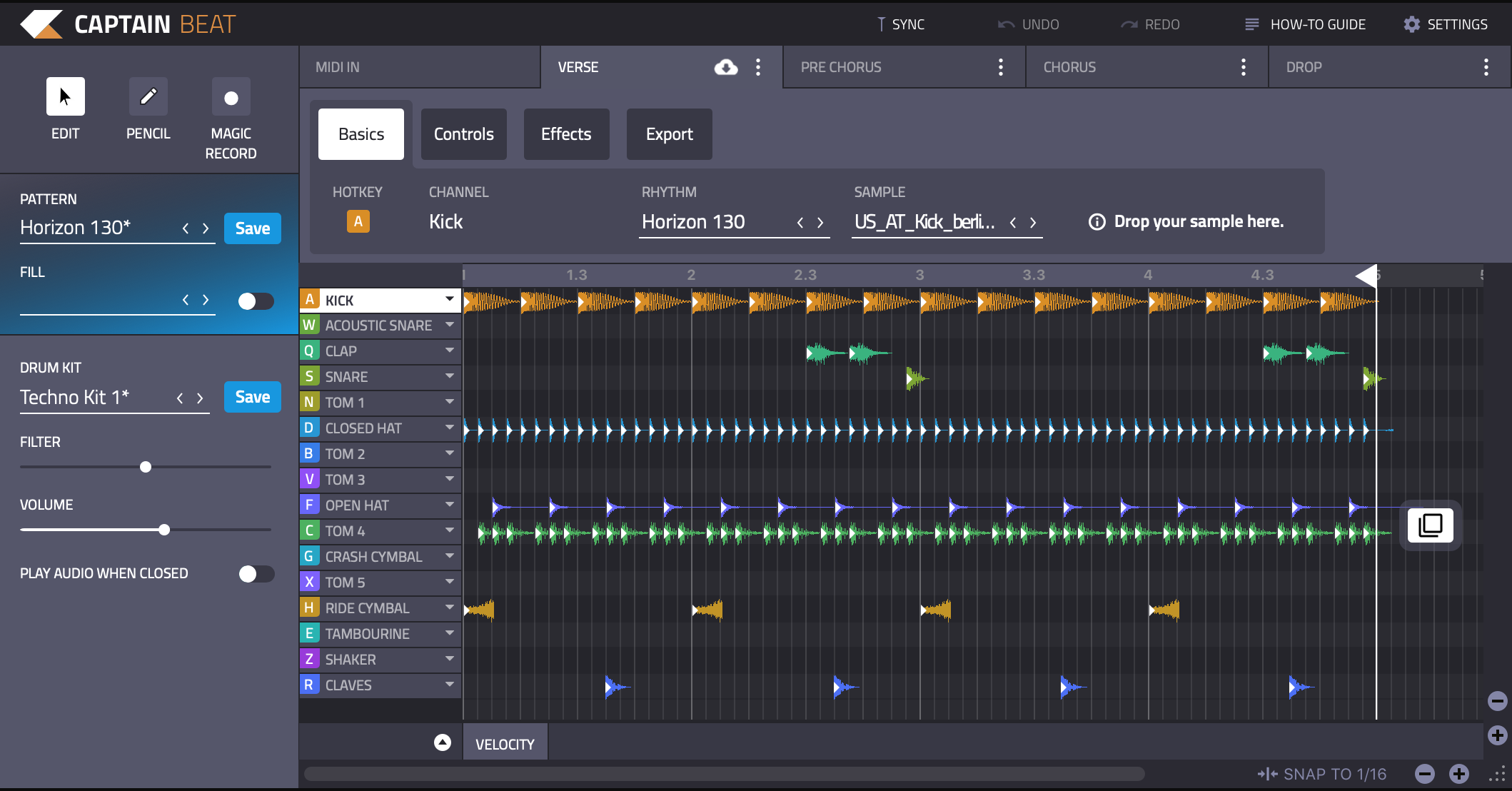
Once I’d imported (drag and dropped) the drum one-shots into Captain Beat, the next step was to get a simple 4-bar loop going. This would form the fundamental drum arrangement which would carry throughout the track. The one-shots used consisted of a kick, snare, closed hat, open hat, reverse cymbal, tom and a tuned percussion sound.

Below you can see the drum programming, a simple four-to-the-floor affair. This included an offbeat snare, claps positioned in the 3rd beat and offbeat positions every second bar. Hat and cymbals are taken care of with 16th closed hats with some velocity variation. Finally, a typical off-beat open hi-hat and a reverse cymbal playing on the first beat of each measure.
Take particular notice of the Tom (Tom 4), as it is providing the sub/bassline of the track with a rolling pattern. This will help to interact with the kick and give a driving feel.
Tune ’em up!
Using Mixed In Key Studio Edition, I then checked and adjusted each drum sound to ensure they were locked onto, or at least close to, the F note to prevent any key clashes. This is only important for the more tonal instruments such as the kick drum, toms and claves. I didn’t tune the hats or claps.
This is how the initial drum pattern sounds, I’ll fine tune it later and swap out some of the drum instruments as the track progresses.
As you can hear it’s a little rough around the edges. However, it gives me a starting point and something that I can tweak as I progress through the track.
At this point I decided to export (drag and drop) each individual drum channel from Captain Beat as audio files into Logic. This will give me lots of freedom to process the drums individually at a later stage.


Time For Chords
Now that I have the fundamental drum elements laid down I can start to consider some of the more melodic elements of the track.
It’s not going to be full-on, harmony, melody, topline and note-shifting shifting bassline, that just isn’t Techno. That said, this driving style is a little more melodic than other forms of Techno. As such, I’ll use several layers of chords with some subtle changes and simple rhythms that interact with the groove of the drums.
The key to making great sounding chords for Techno lies in the timbre (sound preset/design) and the chords used. Using the Tonic chord, in this case F minor, was a good starting point. I can then work out a rhythm to fit the groove of the drums and finally apply some subtle chord changes, although less is more.
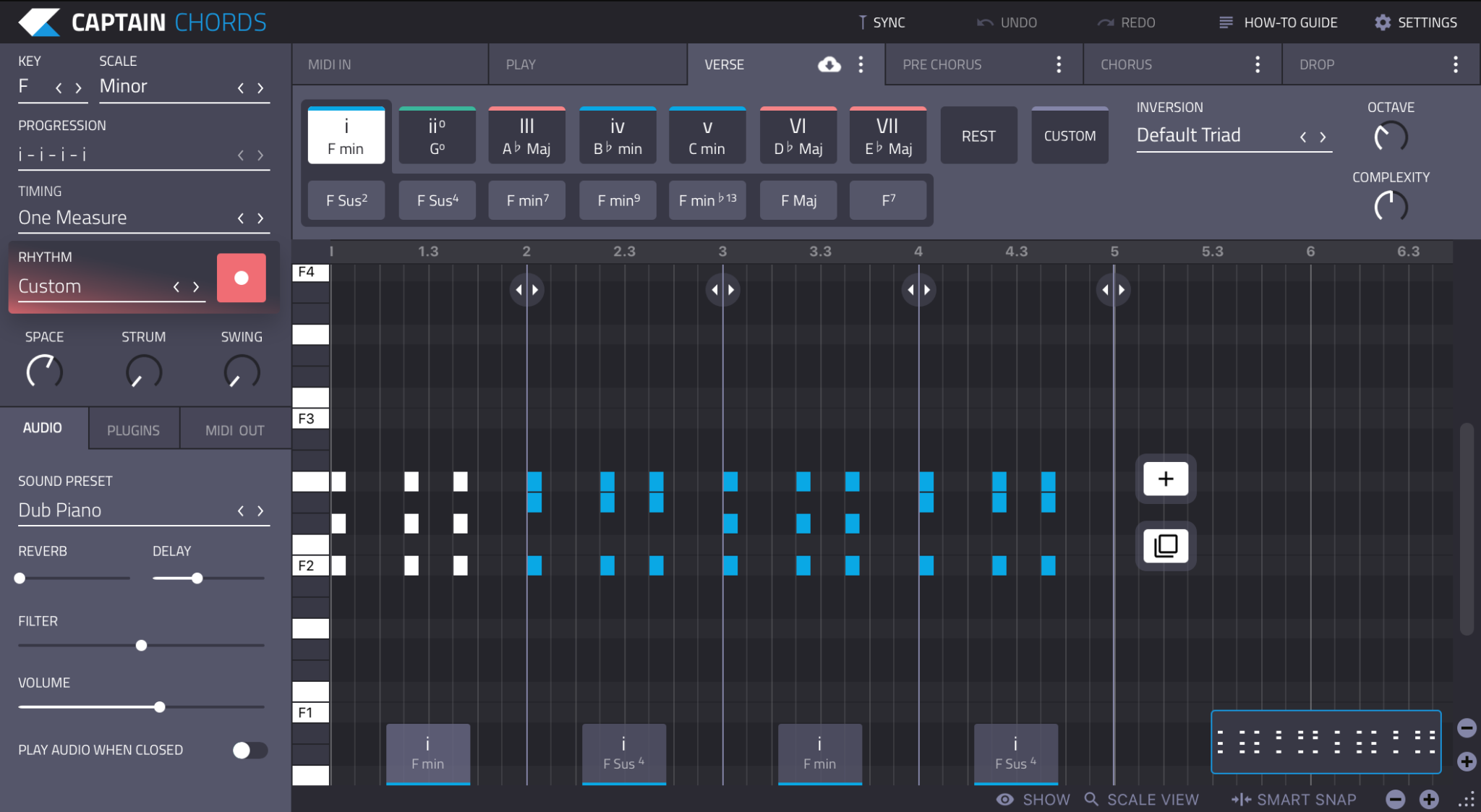
As can be seen above, a simple pattern, alternating between F minor and F sus4, was all that was required to create an appropriately understated Techno chord progression featuring some tension and resolve. Add to that, the dark piano sound ‘Dub Piano’, playing on the 2nd octave, would finish the main rhythmic chord section perfectly.
Here’s how the chords sound.
Add Layers For Interest
Having only one instrument playing chords isn’t going to fill out the track enough. Instead, I opted to increase the instances of Captain Chords to four. This would allow for the main piano chords (above) plus two layers of vocal pads, playing the same chord pattern as the piano, but with Legato notes. Finally, a rhythmical chord stab playing F minor only with a 1-chord-per-bar pattern interacting with the drums.
Legato notes using the same chords as the piano.
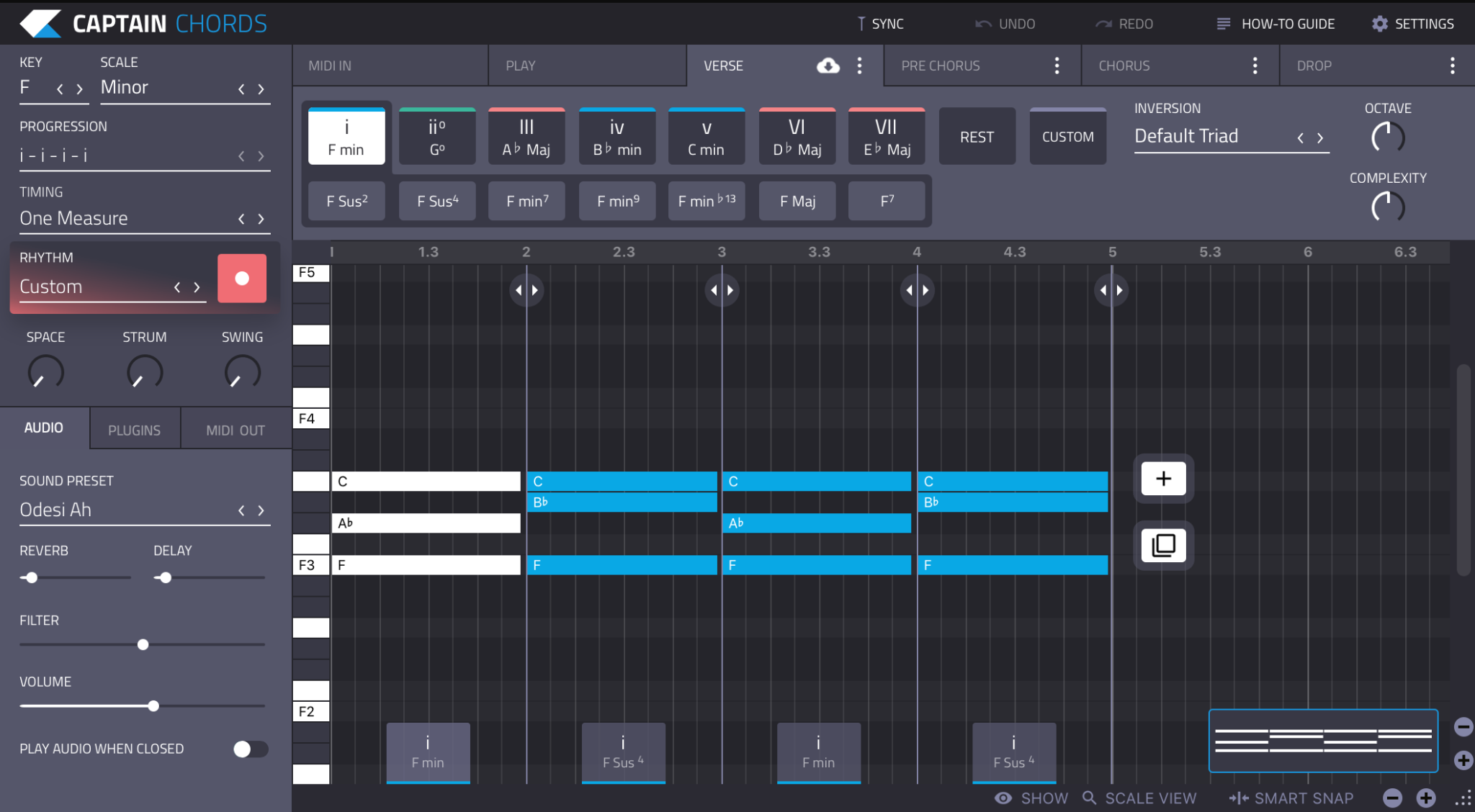
Rhythmical chord stab.
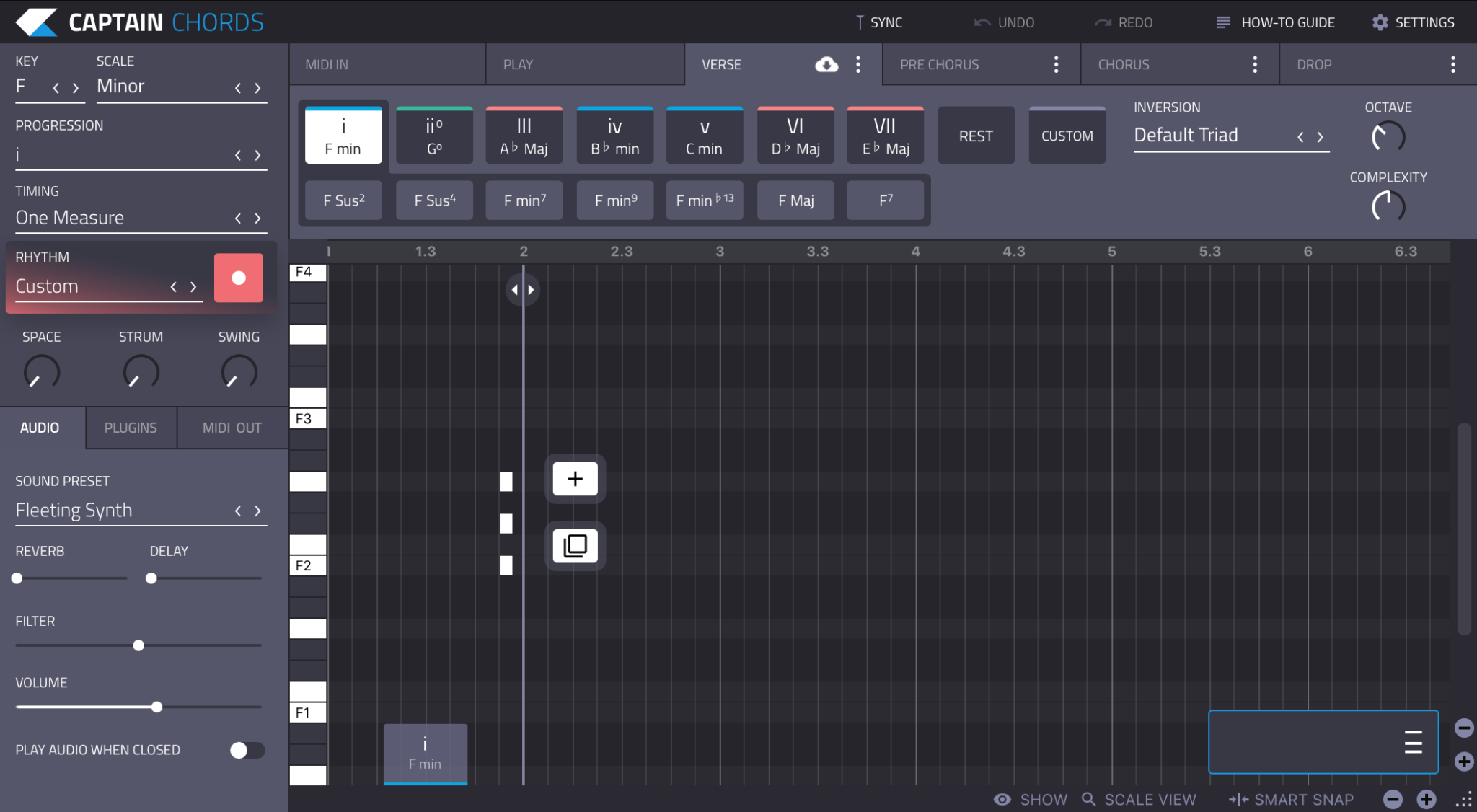
Here’s how the combined layers of chords sound when mixed together.
Install our software
If you want to write your own chords, install our software called Captain Chords.
The Vocal Hook
Almost all of these types of Techno tracks, or at least the ones which seem to achieve the most success, utilize a well known vocal sample. The idea to use the sample ‘Don’t you want me, don’t you want my loving’ from the well known 1990’s dance hit Don’t you want me by Felix, felt like the perfect solution to adding a great vocal hook.
I was able to lift the vocal from the original song using the fantastic Music Rebalance tool from Izotope. However, after checking the song in Mixed In Key, I realised it was not in F minor. This was not a problem as the vocal sample was easily adjusted to F minor using Flex Pitch in Logic. I then used the key/scale quantize option to ensure each note was moved to the nearest note in F minor. Similar features are included in all popular DAWs, so you don’t have to be a Logic user to get the same results.

Finally, a quick time-stretch to ensure the tempo of the sample matched the track. It was now ready to be added to the arrangement. Some ping-pong delay from Echoboy on the second vocal phrase would create a nice effect to lead into the drop.
Here’s the vocal hook positioned in the track.
Tuned Perc
As this style of Techno is quite busy and atmospheric, it’s a good idea to fill out the drums with additional tuned percussion to create interesting textures.
I found a nice percussion loop from the same sample pack I had sourced the drum one-shots. It had a definable tone so the first port of call was to check it using Mixed In Key Studio Edition. It was almost bang on F, but just ever so slightly flat, a tiny adjustment in Logic’s inspector of +30 cents and it fitted perfectly.
Drums, Mixed.
The drums were coming together nicely and after some, EQ, mixing and parallel EQ/compression/distortion, they were starting to sound the way I had envisioned.
Here are the drums mixed. You’ll also notice some slight changes from the original pattern.
Pro Tip
It’s advisable to check the tuning of some of the drum instruments, to ensure the drums gel nicely with the other instruments.
FX
For FX, I decided to use a simple white noise type riser. This is very predictable, I know, but it gets the job done nicely for adding a little crescendo at the end of phrases. Equally, it does a great job for the breaks by simply reversing the sample to create a downsweep. Adding a little side-chain compression pumping to this FX sound is also a nice addition.
After 20 minutes or so of searching my sample library, I stumbled upon a really cool texture with a hint of percussion. It was already in F minor and only required a tiny timestretch to make it fit perfectly.
I wish finding these types of samples was always that easy!
The FX mixed.
Working The Arrangement
It was time to make some decisions on the arrangement, now that all the ingredients were gathered and tweaked to fit the tempo and key/scale of the track.
Typically, most dance music, which takes the form of a club mix, will have a 32-bar intro consisting of mainly drums and possibly a bassline with some rhythmic melodic elements. In keeping with this formula, I put all the corresponding tracks from the first bar till the end of bar 32 in one big block. I then proceeded to play the track from the start whilst muting and unmuting various parts to audition an intro.
The resulting arrangement took this form.
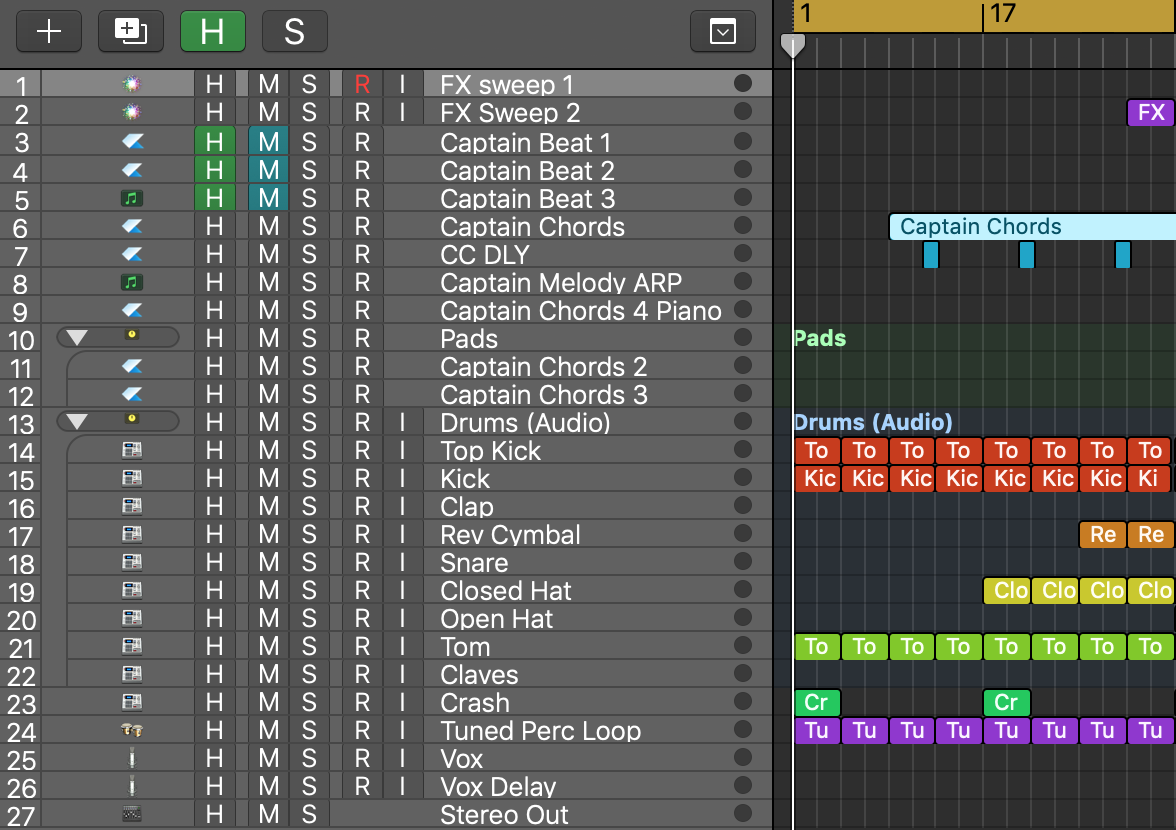
Phrase Markers
Some additional percussion in the form of crash cymbals were added to aid distinguishing the start of new phrases.
Once the intro arrangement was complete a small breakdown section starting at bar 56 help to introduce the vocal was created before returning to the driving beat at the end of bar 72. This was a great position to introduce the vocal pads and continue to build the track overall.
Over the proceeding bars and phrases, the aim was to introduce elements gradually. This would help maintain listener interest. It would also produce an element of tension leading up to what would be a breakdown.
To Breakdown, Or Not?
Techno generally doesn’t do breakdowns, they are more typical of Trance. However, for this style of Techno the rules can be broken and we can add a breakdown. Just don’t opt for the typical 3 minute hands-in-the-air type that would make Armin Van Buuren proud. Restraint should be practiced here.
We won’t delve too much further into the arrangement. However, a breakdown of 16-32 bars, which introduces a new lead synth element would be a sensible, slightly predictable, direction. This could then be followed by a tension-inducing crescendo which would climax with a bass heavy drop around the end of bar 144.
Polishing The Mix
Most of the mixing of the track was done as it was built up, rather than trying to tackle it all at once towards the end of the production process.
Every producer has their preference on this and mine is to mix while I work on the production.
Reach For The EQ
My personal process is to add a parametric type EQ to each new sound introduced to the project, as a first port of call. This usually takes the form of some high-pass EQ to remove any unwanted bass frequencies and muddiness in the lower mid-range. This single action, when used across a full mix and with varying frequency cut-points, can really make a huge difference in clarity and instrument separation – without the need for the more surgical, frequency-specific cuts.
A High-Pass EQ cut on the chords removes muddieness and the masking of other sounds playing the 20-250hz range.
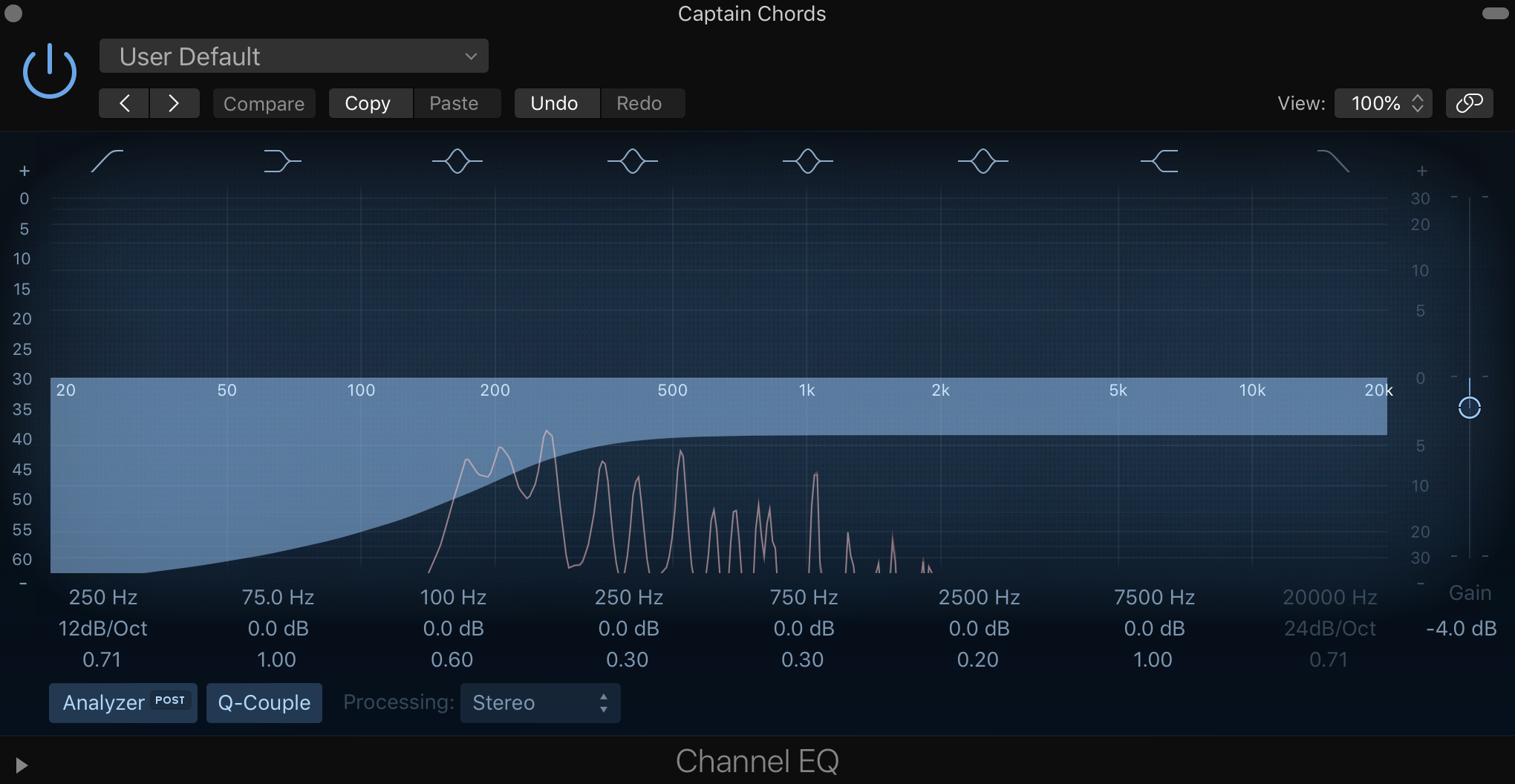
An additional (top) kick was added to support the original kick, but with only the snappy part at around 500-600hz allowed to be audible.
Top Kick EQ
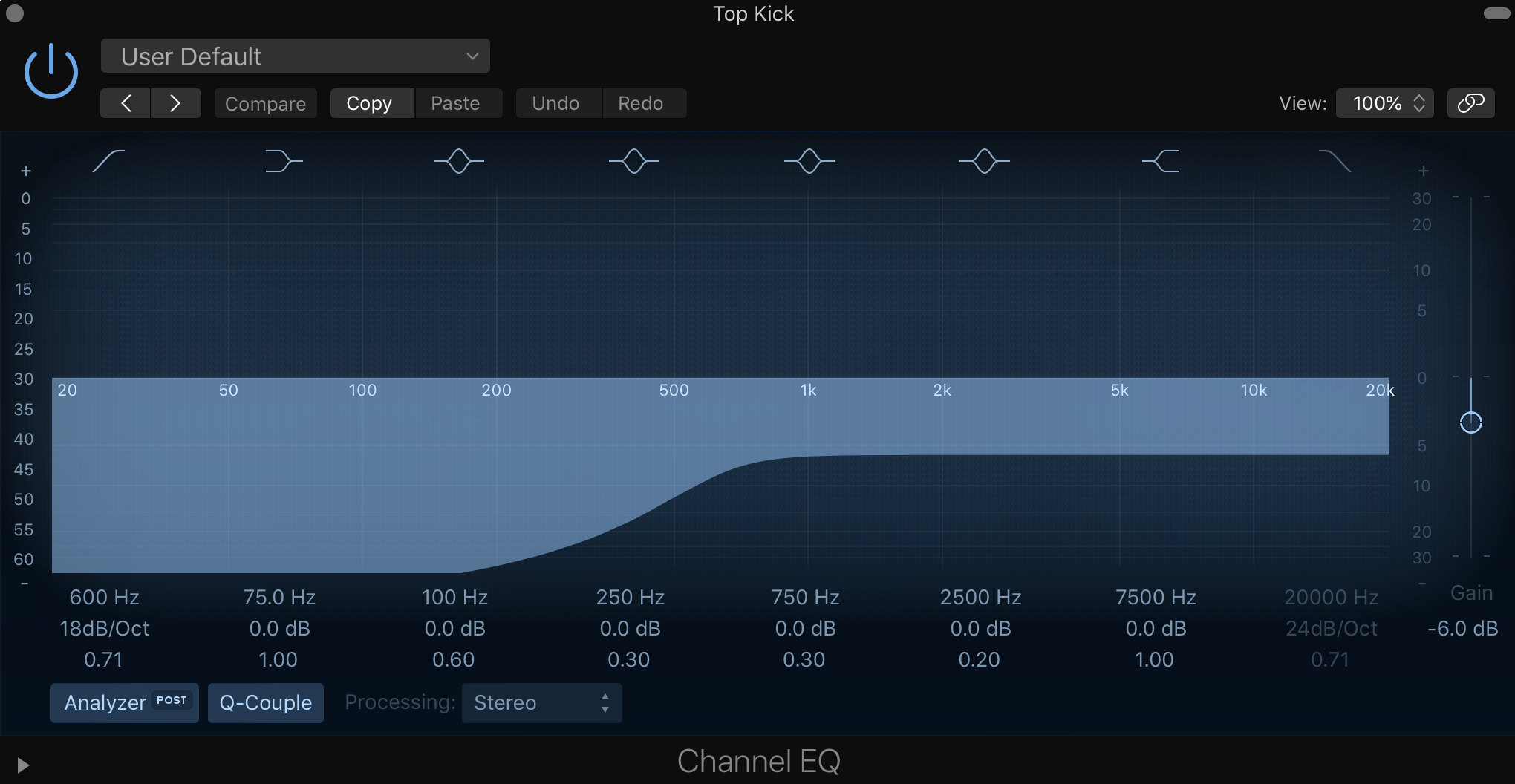
Balance Is Key
Once the majority of EQ is complete, the next step is balancing the various instrument’s volumes. This single process is often one of the hardest tasks in music production, but the result, if done correctly, is game-changing.
Finally, I create group channels to assign similar instruments to. The chords get their own group, as do the drums. This allows some compression to be applied across these instrument groups, which I use to limit their dynamic range. This helps to gel these instruments together and further tighten up the overall balance.
That’s A Wrap
Thanks for joining me on this fun Techno journey and I hope this tutorial helps you to make your own Driving/Peak Time Techno.
We also created a video version of the tutorial, I would highly recommend checking it out too as it goes into more detail on some aspects of the project.
Write your own Chords using Captain Chords
It’s super easy to create your own ideas from scratch. Visit the official Chords homepage and see how it will help you explore music and write your own original productions.
